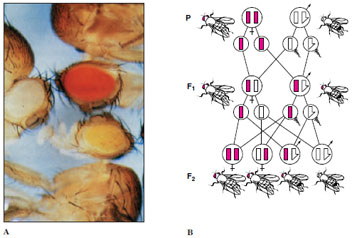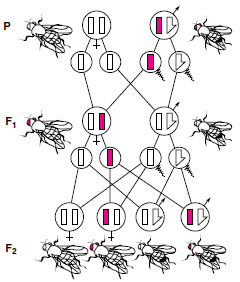Sex-Linked Inheritance
Sex-Linked Inheritance
It is known that inheritance of some
characters depends on the sex of the
parent carrying the gene and the sex of
the offspring. One of the best-known
sex-linked traits of humans is hemophilia
(Internal Fluids and Respiration). Another
example is red-green color blindness
in which red and green colors are
indistinguishable to varying degrees.
Color-blind men greatly outnumber
color-blind women. When color blindness
does appear in women, their
fathers are color blind. Furthermore, if
a woman with normal vision who is a
carrier of color blindness (a carrier is
heterozygous for the gene and is phenotypically
normal) bears sons, half of
them are likely to be color blind,
regardless of whether the father had
normal or affected vision. How are
these observations explained?
The color blindness and hemophilia defects are recessive traits carried on the X chromosome. They are phenotypically expressed either when both genes are defective in the female or when only one defective gene is present in the male. The inheritance pattern of these defects is shown for color blindness in Figure 5-7. When the mother is a carrier and the father is normal, half of the sons but none of the daughters are color blind. However, if the father is color blind and the mother is a carrier, half of the sons and half of the daughters are color blind (on the average and in a large sample). It is easy to understand then why such defects are much more prevalent in males: a single sex-linked recessive gene in the male has a visible effect. What would be the outcome of a mating between a homozygous normal woman and a colorblind man?
Another example of a sex-linked
character was discovered by Thomas
Hunt Morgan (1910) in Drosophila.
The normal eye color of this fly is red,
but mutations for white eyes do occur
(Figure 5-8). A gene for eye color is
carried on the X chromosome. If truebreeding
white-eyed males and redeyed
females are crossed, all the F1 offspring
have red eyes because this trait
is dominant (Figure 5-8). If these F1 offspring are interbred, all F2 females
have red eyes; half of the males have
red eyes and the other half have white
eyes. No white-eyed females are found
in this generation; only the males have
the recessive character (white eyes).
The allele for white eyes is recessive
and should affect eye color only in a
homozygous condition. However,
since the male has only one X chromosome
(the Y does not carry a gene for
eye color), white eyes appear whenever
the X chromosome carries the
gene for this trait. Males are said to be hemizygous for traits carried on the X
chromosome.
If the reciprocal cross is made in which the females are white eyed and the males red eyed, all the F1 females are red eyed and all the males are white eyed (Figure 5-9). If these F1 offspring are interbred, the F2 generation shows equal numbers of red-eyed and white-eyed males and females.
 |
| Figure 5-8 Sex-linked inheritance of eye color in fruit fly Drosophila melanogaster. A, White and red eyes of D. melanogaster. B, Genes for eye color are carried on X chromosome; Y carries no genes for eye color. Normal red is dominant to white. Homozygous red-eyed female mated with white-eyed male gives all red-eyed in F1. F2 ratios from F1 cross are one homozygous red-eyed female and one heterozygous red-eyed female to one red-eyed male and one white-eyed male. |
The color blindness and hemophilia defects are recessive traits carried on the X chromosome. They are phenotypically expressed either when both genes are defective in the female or when only one defective gene is present in the male. The inheritance pattern of these defects is shown for color blindness in Figure 5-7. When the mother is a carrier and the father is normal, half of the sons but none of the daughters are color blind. However, if the father is color blind and the mother is a carrier, half of the sons and half of the daughters are color blind (on the average and in a large sample). It is easy to understand then why such defects are much more prevalent in males: a single sex-linked recessive gene in the male has a visible effect. What would be the outcome of a mating between a homozygous normal woman and a colorblind man?
 |
| Figure 5-9 Reciprocal cross of Figure 8-8 (homozygous white-eyed female with red-eyed male) gives white-eyed males and red-eyed females in F1. F2 shows equal numbers of red-eyed and white-eyed females and red-eyed and white-eyed males. |
If the reciprocal cross is made in which the females are white eyed and the males red eyed, all the F1 females are red eyed and all the males are white eyed (Figure 5-9). If these F1 offspring are interbred, the F2 generation shows equal numbers of red-eyed and white-eyed males and females.




